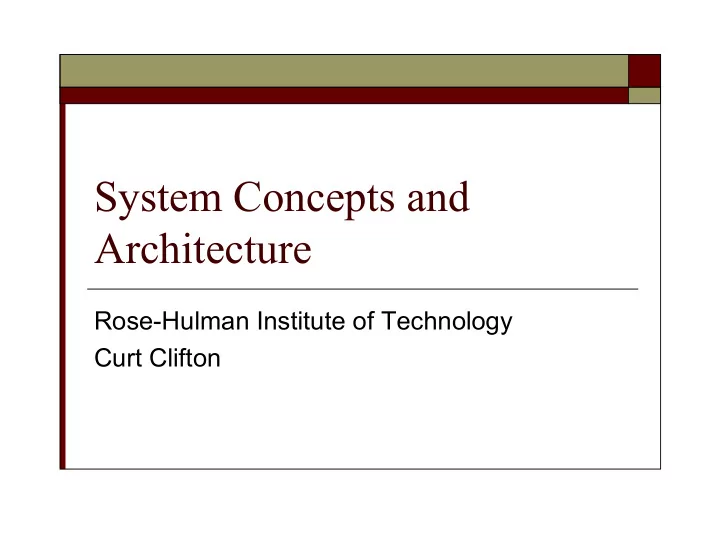

System Concepts and Architecture Rose-Hulman Institute of Technology Curt Clifton
Data Model A set of concepts to describe Database structure Basic operations on the data
Categories of Data Models Conceptual Closest to users’ views Implementation Intermediate level for programmers Physical Actual hardware level
Database Schema A description of the database Not the actual data in it Tends to change seldom Shown with a Schema Diagram
Database State Actual content at an instant in time Every change results in a new state DBMS tries to ensure only valid states occur
Three-Schema Architecture Goals: Support program-data independence Represent multiple views of data
The Three Schemas Internal schema Describes storage with physical data model Conceptual schema Describes entire database structure with conceptual or implementation data model External schemas Describe user views typically with same data model
Data Independence Two kinds: Logical: change conceptual schema without changing external schemas Physical: change internal schema without changing conceptual Just update mappings
Database System Architectures Centralized All processing on one machine Mainframe + dumb terminals Client-Server Specialized server machines for each function Smart client machines provide interfaces Connected via some sort of network
Two Tier Client-Server Client runs UI and application programs Uses API to connect directly to DBMS Perhaps multiple DBMS
Three Tier Client-Server Intermediate layer Application Server or Web Server Advantages Security Scalability Disadvantage Complexity
Entity-Relationship Model Rose-Hulman Institute of Technology Curt Clifton
Entity-Relationship Model Lets us sketch database designs Sketches called ER Diagrams Simple enough share with customers Can convert sketches into implementations Conversion is easy (with practice)
Entity Sets Entity: a “thing” that database tracks Entity set: a collection of similar entities Attribute: property of an entity Simple values, like integers or strings All entities in set have same properties (though different values)
Entity Set Notation Attribute 2 Attribute 3 Attribute 1 Entity Set Name Entity set names are usually singular, i.e. “ Employee ” not “Employees”
Relationships Connect two (or more) entity sets Notation: Entity Set 1 Verbs Entity Set 2 Try to make verbs read left-to-right, top-to- bottom
Values Entity set value: The set of entities in it Relationship value: A set of pairs (or triples, …) with one element from each related entity set
Multi-way Relationships Connect more than two entity sets Useful for more complex relationships
Relationship Constraints One-One: Entity of first set can connect to just one entity in second set, and vice versa 1 1 Entity Set 1 Verbs Entity Set 2
Relationship Constraints One-Many: Entity of first set can connect to just one entity in second set Entity of second set can connect to many in first N 1 Entity Set 1 Verbs Entity Set 2 Use N for arbitrary number greater than 1, or put specific number
Relationship Constraints Many-Many: An entity of either set can connect to many entities in the other set N M Entity Set 1 Verbs Entity Set 2 Use N and M for arbitrary number greater than 1, or put specific number (or omit)
Relationship Constraints Numbers on lines indicate maximums Can also show that every entity must participate M N Entity Set 1 Verbs Entity Set 2 Every entity of first set must be related to at least one entity of the second set
Attributes on Relationships Sometimes attribute is property of relationship instead of either entity Entity Set 1 Verbs Entity Set 2 Attribute
Recursive Relationships When an entity set is related to itself Person Label edges with roles Consider “Cousin Of” wife husband Symmetrical Marries No clear role names
Subclasses Subclass = fewer entities Have more properties Superclass Entity Set Entity of subclass set is also in superclass set isa Has all attributes of both sets Subclass Entity Set
Keys Let us tell entities apart The key for an entity set is a subset of the attributes for that entity set, such that no two entities agree on all the attributes
Showing Keys Each entity must have a key Shown by underlining names of key attributes For subclass hierarchies: Only the root entity set has a key All entities in hierarchy use that key
Weak Entity Sets When even all the attributes aren’t enough for a key… Use a many-one relationship to “borrow” an additional attribute for the key
Example Weak Entity Set Consider football players in a fantasy league Is Name a key? Is Number a key? Need Number + Team Played On name number name Plays 1 Player Team on
Practice with E-R Diagrams In groups of 2–3 work on HW Problem 3.21 On back of handout
Recommend
More recommend